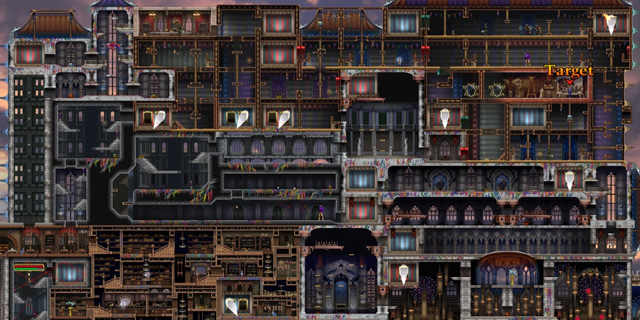
Castlevania: Harmony of Despair hit Xbox Live Arcade back in what seems like a different era now in the downloadable game space. In the intervening time, much has changed, from quality and expectations to price and big-studio presence. Now, it finally sees life on the PlayStation 3, and the new era both helps and hurts its prospects. Thankfully, it’s bringing along a few reinforcements.
The game brings together protagonists, enemies and such from most games in the series in a mash-up environment, allowing up to six to take on the map cooperatively. Each character has its own systems: Soma Cruz collects souls, Alucard relies on his dhampir skills and anyone named Belmont is going to try to hit things with a whip. The game re-uses anything it can, from character sprites to backgrounds to enemy designs. It’s an interesting nostalgic choice; some may deride it as lazy, but we think it’s a distinct approach that you can only take with a series this tenured.
This isn’t exactly Castlevania, though; rather than a huge map to backtrack and go through, each acts as a sort of arena, focusing on pushing through and beating the boss quickly and with minimal damage. We’d best describe it as Castlevania’s all-star game: like real all-star games, it’s more about mashing up the best of the best and less about practice, skill and actual consequences. It doesn’t take much thought and time to get through the content that’s here, if that’s what you’re looking for. The focus is more on approaching situations differently with each character and working to get a better score.
In the PSN version, Konami has bolstered a bit of the game’s feature set. The XBLA game had just as many levels and characters available as DLC as were in the main product, and buying it all was rather pricey. With this release, one of the six bonus levels and two of the DLC characters (Julius and Yoko, if you’re curious) are included. It’s still not everything, but one more level and some experimental time testing out the additional cast adds a good hour to a game that needed the help.
The other addition? Local multiplayer. It still supports the six-player online of the original, but now four can team up on one system and share the screen. The game already allowed you to zoom out to the entire map (though you’d be crazy to play it like that, since you can’t see anything), so it doesn’t seem like it was that hard to include. The game’s better for it, as getting through quickly is interesting when you shout out strategies to friends on the other end of the couch. The camera keeps zooming out as you get further away, though, so while we found it okay to split up some and see what we’re doing due to the simple visuals, you couldn’t go to the complete other side of the map without problems. (If the game were designed for it, we’d probably have seen some functionality like the “bubble” from New Super Mario Bros.) Also to note: local multiplayer breaks the economy in a few respects. Each player gets an item, but they’re all shared, and one weapon can be equipped by all characters at once. If the game relied on the system more for gameplay tension, it would be a worse problem, but it just means you’ll have more gold than you can spend before you beat all the levels. In some ways, we wish they would have included 6-player local support, since the system seems like it could support it as there’s no split-screen or anything. But we get that we’re crazy people and not many would actually use it.
Are these additions enough to make the game a must-have, or are they too little for an older game to have success? That we don’t know. What we do know is this: the PSN version of Castlevania: Harmony of Despair is the most full-featured version of a game designed to please series fans, and its second landing is in a market more comfortable with a $15 price point. We think it’s worth a look.
Pros: Lots of love for series fans, added characters and local play
Cons: Camera issues with multiplayer, short first playthrough



















